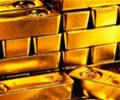
Gold tried for back-to-back gains with an early advance Tuesday, flicking at the closely watched $1,200 line that some analysts see as a major determinant for gold’s near-term fate.
The precious metal on Monday logged the best single-session gain of August so far, as prices bounced back from their worst weekly decline in more than a year.
A pullback for the robust dollar has largely explained gold’s latest move as the two have enjoyed an inverse relationship for the bulk of the year. Yet gains for gold came even as the S&P 500 SPX, +0.33% which tends to move in the opposite direction of bullion, flirted with record highs Tuesday.
December gold GCZ8, +0.23% was up $5.30, or 0.4%, at $1,199.90 an ounce. Gold climbed $10.40, or roughly 0.9%, to settle at $1,194.60 Monday—the largest one-day dollar and percentage increase for a most-active contract since July 31, according to FactSet data. A popular metals exchange-traded fund, the SPDR Gold Trust GLD, -0.09% was up 0.5% Tuesday.
Market participants attributed some of bullion’s recent gains to investors wagering that the commodity has achieved a tentative bottom. But several analysts, including Naeem Aslam, chief market analyst at Think Markets UK, have said gold needs to break above $1,200 and hold or Monday’s rally could be chalked up to a bull trap. Gold remains down around 9% year to date.
The dollar fell and gold gained Monday after reports President Donald Trump criticized Federal Reserve Chairman Jerome Powell for delivering rate increases. In a subsequent Reuters interview, Trump again criticized Powell. Attention could remain on central bank interest-rate policy as Powell and other central bankers gather for the Kansas City Federal Reserve’s annual symposium in Jackson Hole, Wyo. The Fed is expected to raise rates next month and one more time this year, while continuing on a course of mild rate increases next year.
The ICE U.S. Dollar Index DXY, -0.26% a gauge of the currency against a half-dozen counterparts, was down 0.4% at 95.55. Boosted by higher U.S. rates relative to other major economies in the world, the dollar has advanced 3.7% so far this year and 1.6% in August. A stronger U.S. currency can be a negative for gold because it makes dollar-pegged assets, like gold and silver, more expensive for buyers using other currencies.
“There are points in time when gold is driven more by real rates [with nonyielding bullion giving way to higher-yielding investments], but right now correlation with the dollar is very high and will continue at least in the short term to drive gold trade,” said Marisa Hernandez, metals and mining equity analyst at Neuberger Berman.
Notably, there’s a key supportive factor for gold prices in play as well, she said: the cost curve for miners. Should gold linger in the $1,150 to $1,200 area, Hernandez said, miners won’t make enough to invest in pulling out more gold and will cut production. The market price would presumably level off again.
”The price can always dip below that [$1,150 to $1,200 range], but it shouldn’t be sustainable for a long period of time and that means you may not have a lot of downside for prices from here,” she said. “But you do need the dollar to be weaker for the gold price to rise significantly from here, too.”
Hernandez said $1,150 on the downside and $1,350 on the upside feels appropriate for gold for the foreseeable future, especially given current interest rates, inflation and dollar behavior.
Among other metals, high-grade copper for September delivery HGU8, +1.14% was up 2 cents, or 0.4%, at $2.6945 a pound, while September silver SIU8, +0.55% added 10 cents, or 0.7%, to $14.77 an ounce.
October platinum PLV8, -0.24% advanced $7.60, or 1%, to $801.50 an ounce, after plumbing lows not seen in a decade in recent sessions. September palladium PAU8, +0.47% rose $5.90, or 0.7%, to $904.60 an ounce.
Source: MarketWatch

